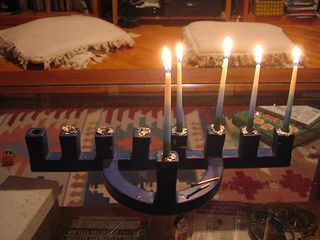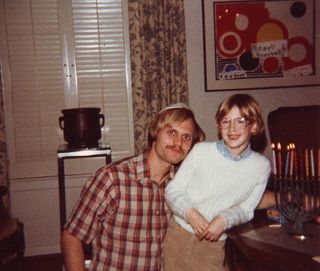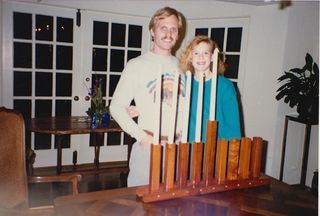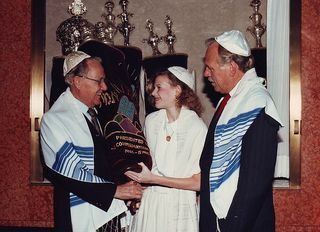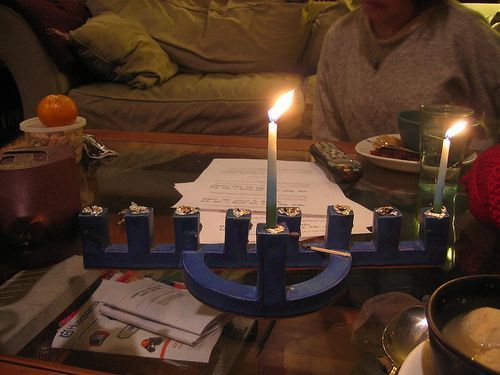Rachel Barenblat's Blog, page 138
January 1, 2015
Essay in Shma Koleinu
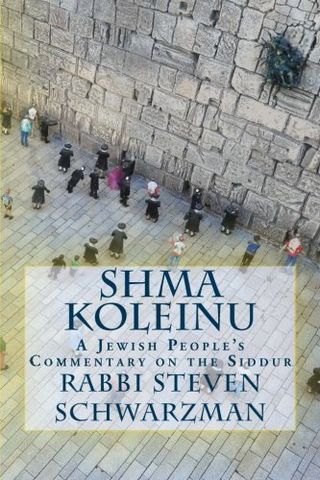 Happy Gregorian new year! I'm delighted to be able to begin the year with news that I have an essay in a new anthology of Jewish voices on prayer. It's called Shma Koleinu: A Jewish People's Commentary on the Siddur, edited by Rabbi Steven Schwarzman, and my essay is about one of my very favorite prayers, the modah ani prayer for gratitude.
Happy Gregorian new year! I'm delighted to be able to begin the year with news that I have an essay in a new anthology of Jewish voices on prayer. It's called Shma Koleinu: A Jewish People's Commentary on the Siddur, edited by Rabbi Steven Schwarzman, and my essay is about one of my very favorite prayers, the modah ani prayer for gratitude.
Here's how the publisher describes the book:
Shma Koleinu: A Jewish People's Commentary on the Siddur will take you through deep reflections on prayers in the Jewish prayerbook, giving you new insights into the prayers and new courage to find your own.
Rabbi Steven Schwarzman and other writers, including rabbis, cantors, and "ordinary" people - people just like you - delve deeply into the prayers, their texts, their history, their melodies - and just as deeply into themselves.
As the Talmud says, come and hear. Come and hear these voices, and use them to strengthen your own voice in deeper Jewish prayer.
Advance reviews have been good, and I'm excited to see the whole book (my copy is on its way to me now.) Here's some of what people are saying:
"Shma Koleinu: A Jewish People's Commentary on the Siddur is just what the Jewish community needs: a commentary that consists of real and personal prayer experiences. This is not a removed, ivory-tower, collection of philosophical theories, but rather a collection of down-to-earth, engaged, deeply felt responses to the Jewish worship experience. That is why it is so powerfully inspiring!" - Rabbi Jeff Hoffman, D.H.L., Rabbi-in-Residence and Professor of Liturgy at The Academy for Jewish Religion, NY.
"Rabbi Steven Schwarzman has gathered a splendid collection of inspiring interpretations of many of the most important prayers in the Siddur. Reading these meaningful and personal readings on the Jewish treasure-house of petitions, supplications, and words of praise, will greatly enhance the spiritual experience of any worshiper." - Rabbi Dov Peretz Elkins, author of In the Spirit: Insights for Spiritual Renewal in the 21st Century
Order yourself a copy now! If you buy it via this Amazon link, a small donation will be made to ALEPH: the Alliance for Jewish Renewal.
December 31, 2014
What's next for Zeek?
I've been honored to be a part of Zeek magazine for many years -- as a contributor, a contributing editor, and now a board member. What began as a Jewish journal of thought and culture is now one of the strongest voices speaking the Jewish progressive call for a redeemed world.
And like many other independent publications, we're struggling financially. We've started an indiegogo funding campaign with hopes of raising $3600 to get us through the first quarter of 2015, during which time we hope to implement plans for longterm sustainability.
At ZEEK Magazine, we work each week to develop and lift up emerging and established Jewish voices on social change, spirituality, arts and culture. We delight in the intersections and new ideas that make this landscape feel vibrant and cultural shifts and social change possible.
What makes us different is how we do it: by giving readers a way to engage whenever possible so you can do more than just read or reflect, you can take action.
I'm really proud of the work I've been able to do with Zeek -- from the 2008 roundtable the Synagogue / Israeli Politics Mashup, to the 2009 interview with Rachel Adler, to New depths in Jewish/Muslim dialogue: Jewish privilege, which Zeek published earlier this year.
If you think Zeek has a meaningful role to play in the Jewish cultural and ethical scene, please consider making a donation to our indiegogo fundraiser. Any donation, no matter how small, will make a difference. Thanks, all, and happy secular new year!
December 29, 2014
Vayechi: a blessing at bedtime
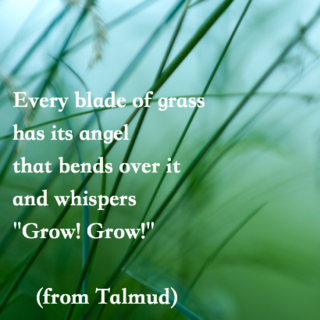 Here's the d'var Torah I offered at my shul yesterday.
Here's the d'var Torah I offered at my shul yesterday.
Jacob, on his deathbed, places his hands on his grandsons Ephraim and Menashe. And he says:
The angel who rescued me from all harm -- bless these boys! May they carry on my name and thus name of my ancestors, Abraham and Isaac. May they spread far and wide upon the earth.
Jacob seems to be referring to a specific angel here. The only angel we know of, in his story, is the angel with whom he wrestled on the eve of reuniting with his brother. He wrestled with that angel until dawn and then said "I will not let you go until you bless me!" In return, the angel gave him a new name, Yisrael, One Who Wrestles With God. That's who he's asking to bless his descendants: not a "guardian angel" as pop culture defines the term, but the angel who redeemed him with an all-night struggle.
As the children of Israel, we inherited his wrestle. We're Godwrestlers. We give ourselves to the holy work of wrestling with God, wrestling with Torah, wrestling with the world's imperfections. And that wrestling is itself a kind of redemption. It lifts us out of a state of passive receptivity. When we wrestle with God and with Torah and with injustice in the world, we are transformed.
Jacob's request for blessing has become part of the traditional liturgy for the Bedtime Shema.1 There's also another piece of that liturgy which mentions angels: a song where we ask four angels, Wonder, Strength, Light, and Comfort -- or using their Hebrew names, Michael (Who is Like God), Gavriel (God's Strength), Uriel (God's Light), and Raphael (God's Healing) -- to bless us as we sleep. I sing this to our son every night at bedtime.
Some of you may be thinking: wait a second. It's one thing to say that Jacob encountered an angel. But us? In modern life today? Asking angels for blessings?
Bear in mind that "angels," in our tradition, doesn't mean winged cherubs with haloes. In Jewish tradition, an angel is a messenger from God, doing God's work in the world.
The people we meet may serve as angels for us. There's a teaching in Jewish tradition which holds that every blade of grass has an angel which sits over it and whispers "Grow, grow!" If every blade of grass is cheered on by an angel, surely we are too. Maybe when we offer praise and encouragement to each other, we embody those angels. In the Angel Song I referenced earlier, qualities like Wonder and Strength are called angels. Maybe when we cultivate our own wonder, we connect up with the Angel of Wonder.
Returning to Jacob's prayer, "May the angel who rescued me from all harm bless these boys:" traditional Jews recite it every night, and I think we can learn something from its placement in the bedtime ritual. Here's how that ritual goes:
1) The first step in getting ready for sleep is forgiveness. The liturgy for Kriat Shema al-ha-Mitah begins "I forgive anyone who has hurt me, through deeds or actions, in this lifetime or any other." This way, if I die in my sleep tonight, I won't be carrying the karmic baggage of grudges.
2) Then there's a prayer blessing God Who brings us to sleep. We ask God to let our sleep be peaceful until we wake in the morning to gratitude again. We ask God to shelter us beneath a shelter of peace all night. Once we've cultivated forgiveness, we're ready to be peaceful.
3) Then we recite the words from this Torah portion, asking the angel who blessed Jacob to bless us.
4) The traditional liturgy ends with Adon Olam, which closes with the verse "Into Your hands I place my spirit, when I sleep and when I rise; and with my spirit, my body too; God is mine, I will not fear!"
When we've offered forgiveness, and acknowledged the Oneness at the heart of all things, then we become ready to ask our very struggles to bless us as we surrender to the night. And when we can experience our struggles as angels bearing blessings, then we can know ourselves to be in God's loving hands when we sleep and when we wake. Kein yehi ratzon: may it be so!
1.Maybe you didn't know there was a liturgy designed for reciting at bedtime. There is; it appears in most siddurim; you can find the Hebrew prayers here at Open Siddur, and here's a nice exploration of the bedtime shema liturgy and its themes.↩
December 25, 2014
Reb Zalman, Rev. Howard Thurman, and Christmas
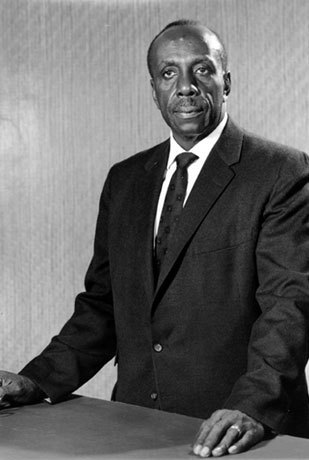 My teacher Reb Zalman (Rabbi Zalman Schachter-Shalomi z"l) frequently told the story of how, when he began studying religion at Boston University, he used to enter the chapel each morning to pray shacharit, Jewish morning prayers. But he found that the crucifix which occupied a central place in that chapel made him uncomfortable, so he chose to pray in a closet instead.
My teacher Reb Zalman (Rabbi Zalman Schachter-Shalomi z"l) frequently told the story of how, when he began studying religion at Boston University, he used to enter the chapel each morning to pray shacharit, Jewish morning prayers. But he found that the crucifix which occupied a central place in that chapel made him uncomfortable, so he chose to pray in a closet instead.
Shortly after he began this practice, he noticed that someone had moved the crucifix aside and placed the Bible in the center of the room in apparent deference to his needs. In entering the chapel a bit early one morning, he saw who was moving the cross -- an African-American man who he didn't recognize, but assumed (from his humility and his quiet service) might be the janitor.
He wanted to study religion from an academic perspective, but was in those days still very close to his Chabad roots, and he questioned whether academic study of religion was "kosher" for him. So one day he decided to go and visit the dean, one Reverend Howard Thurman.
Imagine his surprise when he entered the dean's office and saw the very same man who had moved the cross to make him more comfortable! (I always heard multiple things in his voice at once when he told that part of the story -- chagrin that he had mistaken a dean for a janitor, alongside amusement at how the Holy One of Blessing works in mysterious ways.)
Reb Zalman admitted his fears about the academic enterprise at hand: would it shake his faith? Would it cause him to doubt? "Don't you trust the ruach ha-kodesh?" asked Reverend Thurman. (Ruach ha-kodesh is Hebrew for "holy spirit," more or less.) Reb Zalman realized that of course he did, and that if God had led him there, surely it was where he was meant to be.
I thought of that story again when I found, on the blog Telling Secrets, a beautiful poem from that same Reverend Howard Thurman. Although I am Jewish, I find profound resonance in his poem about Christmas:
When the song of the angels is stilled,
When the star in the sky is gone,
When the kings and princes are home,
When the shepherds are back with their flock,
The work of Christmas begins:
To find the lost,
To heal the broken,
To feed the hungry,
To release the prisoner,
To rebuild the nations,
To bring peace among people,
To make music in the heart.
For those who celebrate, may today be meaningful. And may all of us enter, in days to come, into wthe holy work of finding the lost, healing the broken, bringing peace among people. Speedily and soon, amen.
(For more on Reb Zalman z"l, there's a wonderful PBS interview at Religion & Ethics Newsweekly: Extended interview with Rabbi Zalman Schachter-Shalomi. He tells the Rev. Thurman / ruach ha-kodesh story in that interview too.)
December 24, 2014
Happy Erev Christmas
 I've taken to posting a message on my congregational blog at this time each year, entitled a greeting from the rabbi before Christmas. I wrote it and shared it there last year, and received a lot of response from people with whom it resonated. It seemed worth reposting this year.
I've taken to posting a message on my congregational blog at this time each year, entitled a greeting from the rabbi before Christmas. I wrote it and shared it there last year, and received a lot of response from people with whom it resonated. It seemed worth reposting this year.
It sometimes seems as though our options at this season are either to dislike Christmas (to feel disenfranchised by its ubiquity and Othered by our minority status) or to embrace it and assimilate altogether (losing our Jewishness in the process.) But I think there are more choices than those.
Christmas isn't "our" holiday. For me that's part of its charm. As a working rabbi, there's something delightful about being able to relax on someone else's festive day -- knowing that my Christian colleagues are leading late-night services tonight while I have the option of relaxing in my PJs. (Have fun, y'all.)
I know that I have friends for whom Christmas is a truly meaningful religious time. I enjoy getting glimpses of their religious festival: learning about their theology, hearing their holy songs, resonating with the themes of their sacred story. I've always loved these things. What a glorious wealth of music, story, and tradition has arisen over the course of two thousand years of the Christmas story. My love of, and my practice of, my own tradition isn't diminished by the existence of theirs alongside it.
And I also have friends who experience the day purely as a midwinter festival of gift-giving. For some people the decorated fir tree may have become associated with the cross, but for most it's a fragrant symbol of renewed life in darkest midwinter having nothing to do with Jesus. (And it hasn't always been Christian custom. The early Christian church condemned the decoration of one's home with evergreen boughs, and the Puritans preached against the "heathen custom" of the decorated tree.)
Holiday lights of various kinds lift my spirits at this time of year -- whether or not they're derived, as some argue, from ancient customs of burning a solstice bonfire. And there's always the tradition of eating Chinese food, which Jews have evidently been enjoying on Christmas since the late 1800s. Most of all, I enjoy it when people are kind to one another, and the existence of Christmas seems to spur a lot of people to be nicer and more generous at this time of year. I'm always in favor of that.
I said earlier that Christmas isn't "our" holiday. But that binarism has been complicated by the reality of dual-heritage families. Today many Jews do feel some ownership, because we have Christian family. For some of us, Christmas has become at least partially "ours." Perhaps we hang ornaments on an evergreen, in our own home or in the home of in-laws; or give and receive gifts; or accompany family to late-night services. I don't believe that doing any or all of these makes one "less Jewish."
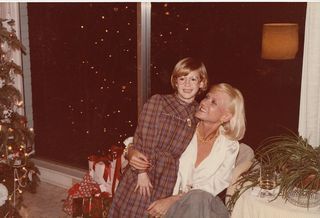 For others, this can be a time to celebrate with Christian friends even though this holiday isn't "ours" at all. One of my congregants told me that for her, Christmas is like someone else's birthday. "If I'm invited to their party, I go and I have a great time, even though it isn't my birthday."
For others, this can be a time to celebrate with Christian friends even though this holiday isn't "ours" at all. One of my congregants told me that for her, Christmas is like someone else's birthday. "If I'm invited to their party, I go and I have a great time, even though it isn't my birthday."
I love that comparison. Christmas celebrations are like someone else's birthday party. (Come to think of it, they are someone else's birthday party -- that nice Jewish boy described in Rabbi David Zaslow's excellent book Jesus: First-Century Rabbi.) But there's no need to feel threatened by celebrating someone else's simcha.
That's the attitude with which I grew up. My parents had both Jewish friends and Gentile (Christian) friends, and I have many fond childhood memories of Christmas parties which we attended together. The photo of my mother and me which illustrates this post comes from one such party, in 1982.
Whatever your relationship with the holiday may be, I wish you a merry erev Christmas! I'm always tickled at the fact that Christmas is a holiday that Christians celebrate the way that we do -- not starting at sunup, but beginning the night before, an eve followed by a morning. (All Jewish holidays begin at sundown; for that matter, all Jewish days begin at sundown. Think of how the passage of time is first described in Torah: "and there was evening and there was morning, the first day.")
I hope that your night, and your day, are merry and bright.
Related: On "Otherness" and Christmas, 2012.
[image error]
December 20, 2014
Miketz and Chanukah: letting your light shine
Here's the d'var Torah I offered at my shul this morning. (Cross-posted to my From the Rabbi blog.)
The first thing Joseph does, when summoned from Pharaoh's dungeon, is shave and change his clothes. Presumably he does this because it's not appropriate to appear before the ruler of the land in rags... but given the importance of clothing in the Joseph story, I see something deeper.
Remember his coat of many colors. Remember the garment which he relinquished to Potiphar's wife in escaping from her clutches. Remember Tamar, who disguises herself in a cloak in order to orchestrate justice. Clothing in this story is symbolic of internal reality.
As a child I learned from my mother that how we dress gives us an opportunity to show respect for others. We dress nicely because that's a way of showing the people we meet that they matter. Surely that's part of what Joseph is doing at this moment in his story.
I also learned from my mother that how we dress can impact how we feel inside. When I'm not feeling great, sometimes brushing my hair and putting on lipstick can help me perk up and feel ready to face the world. That may have been part of what Joseph was doing, too.
And another thing he may have been doing is adjusting his outer appearance so that it matches what he knows about himself inside. A number of Hasidic teachers speak about the tension between pnimiut, what's hidden deep inside, and chitzoniut, the external face one presents to the world. We each carry a divine spark inside. That spark connects us with the Holy One of Blessing.
That spark is the source of our light; as we read in psalms, "the soul of a person is the candle of God." As we kindle candles, God kindles souls. If we're willing to be kindled, we can carry divine light into the world. But we each get to choose whether and how to reveal that light.
For me, one of the challenges of spiritual life is trying to ensure that my external face matches my internal light. Deep down, I'm always connected with God. But can I manifest that reality in the face I show to the world? Am I willing to risk letting my inner light shine?
Because it does feel like a risk sometimes. This world doesn't always reward those who let their light shine. I could be laughed at. I could be sneered at. I could be told that I am delusional, or naive. Someone could lash out at me because they don't like my light.
One of the primary mitzvot of Chanukah is pirsumei nes, publicizing the miracle. This is the origin of the custom of putting a chanukiyah in the window or in a public place -- because we're not supposed to keep it hidden, we're supposed to let the light of Chanukah shine.
As we're supposed to let the light of our souls shine. Whatever clothing we wear, whatever persona we adopt, it's our job in this world to be human candles. To shed light in the darkness, wherever we go.
When do you feel most able to let the light of your soul shine through?
Who are the people who help you cultivate that feeling?
Where are the places, what are the practices, which help you shine the most?
This Chanukah, will you rededicate yourself to letting your light shine?
December 19, 2014
Worth reading (on Chanukah)
We are all of us afraid of the dark. At night, anxieties suppressed or repressed come swimming to the surface of consciousness: am I safe? Am I loved? Am I needed? Is there meaning in the world, or is it all, ultimately, just a swirl of chaos?...
Judaism does not ask us to ignore this darkness and the sense of doom it might educe in us. On the contrary, it asks us to face them squarely, and then, ultimately, to defy them. But how?...
"The soul of man is the lamp of God," the Book of Proverbs tell us (20:27). What this means is that ultimately, our task is not to light candles, but to be candles. We have the potential to be the bits of light that help bring God back into a world gone dark. As the Sefas Emes puts it in discussing Hanukkah, "A human being is created to light up this world" (Hanukkah, 1874).
All of these brief quotes are from Lighting Up the Darkness by Rabbi Shai Held. His whole essay is beautiful and I commend it to you.
Tonight we'll enter into the fourth night of Chanukah. Chag urim sameach -- wishing you a joyful continuation of the festival of lights! And Shabbat shalom, too.
Photo: fourth night of Chanukah. From my flickr stream, taken a few years ago.
December 18, 2014
Three from the vaults - old Chanukah photos
For #throwbackthursday, here are three old Chanukah photos. The first two of these are photographs of me with my middle brother.
This one's about 30 years old. If you look closely you can see my homemade Chanukah decorations taped to the framed Calder print on the rear wall. I think this was taken the year that my parents were in Kenya over Chanukah, traveling with a friend who was a hematologist and whose work frequently took him to Nairobi. My parents traveled with a tiny chanukiyah which held birthday candles, and arranged for me to celebrate Chanukah with different family members on different nights.
And this one's from 1988. My bat mitzvah took place on Shabbat Chanukah, so my brother -- who is a woodworker in his spare time -- made this beautiful chanukiyah which holds twelve-inch tapers. We lit it at my bat mitzvah, and my parents used it for many years thereafter. People in Texas like to joke that everything is bigger there; this chanukiyah definitely fits that bill.
(That same brother is responsible for the giant mahogany dreidel which I brought to Massachusetts during my last year of college. I remember placing it on the coffee table in the house I shared with several friends that year. When I came back, one of my housemates held the dreidel reverently in his hands. He looked up at me and without missing a beat said "very large Jews have been here!")
While I'm indulging in Chanukah remembrances, I want to honor the fact that today is my maternal grandfather Eppie's 18th yahrzeit. (Here is a post I shared about him ten years ago on this Hebrew date.) This photograph was staged on the day before my bat mitzvah, which was during Chanukah - you can see my father on one side, my grandfather Eppie z"l on the other, handing the Torah to me.
I hope that your Chanukah continues to be joyous and bright!
December 16, 2014
Happy Chanukah!
Tonight at sundown we'll enter into the Festival of Lights, also known as the Festival of Rededication, also known as Chanukah. (Or Hanukkah. Whatever. It's a Hebrew word. Its real spelling is חֲנֻכָּה -- I think the English variant with the "ch" comes closest, but mileage varies.)
First candle in the chanukiyah.
(Chanukiyah may not be a familiar term for everyone. A chanukiyah is a special menorah made for Chanukah, with eight branches and a ninth candle for lighting the others, instead of six branches and a seventh candle for lighting the others which is what you would find on a menorah designed for giving light but not specifically for commemorating the miracle of the oil which burned for eight days.)
If you're looking for some good Chanukah-themed reading, I recommend Abigail Pogrebin's recent 'A Split in the Jewish Soul': Hanukkah Reconsidered in the Forward. It's part of her excellent "Wondering Jew" series, and it opens up some important questions about the holiday and what it means to us as modern Jews -- especially as we struggle with questions of innovation and change.
Or, on a different note: Chanukah Human Menorah. "Do-it-yourself menorahs are quite common this time of year. Take some sort of material, a little arts here, a little crafts there, and you have yourself a handcrafted, bespoke fixture of light. // Can we apply these basic elements to transform our personal lives into menorahs? Can we, as human beings, become fixtures of light in everything we do?"
To all who celebrate, I wish a joyous Festival of Lights! May we all experience increased light during these dark days.
December 15, 2014
New essay in Beyond Walls - and a chance to learn with me next summer!
I have an essay in the Beyond Walls digital magazine this week. My essay is about how writing can be transformative (in the personal / spiritual sense, not the fannish sense), and it's called Transformative Work. Here's a taste:
Writing can transform. In writing, we are in transit: boundary-crossers moving from one state of being to another. (This is the meaning of the Hebrew word Ivrim, usually rendered as "Hebrews;" etymologically, to be an ivri is to cross over.) All writers are in some way boundary-crossers, or if you prefer, boundary-bridgers. In writing, we reshape the world around us, forming new realities on the page. My tradition teaches that God speaks the world into being in every moment. We are made in that image. When we write, we create worlds.
Writing—the act of writing; the gerund which implies continuing practice—can be transformative. When I sit down to write, I'm opening myself to the possibility of transformation. I'm embracing the possibility that in the process of writing I will find myself changed. This is true whether I am writing liturgy, or poetry, or a blog post about this week's Torah portion.
Writing is a journey with an unknown destination...
(Read the whole thing: Transformative Work.)
The reason my work is featured in this magazine is that I'll be teaching next summer at a week-long writing workshop for clergy. It's called Beyond Walls Spiritual Writing Institute, and it will be at Kenyon College.
Here's a description:
You already feel confident writing to those you know in your church or synagogue. Yet clergy of all faiths tell us that there’s another conversation that matters, outside their institution’s walls, among those who aren’t there for services, but are reading, thinking, caring about living a moral and spiritual life. This is your chance to learn the best ways to join that conversation.
This one-week writing intensive program teaches you how to be a more expressive, authentic, and skilled writer, honing what you have to say and becoming more proficient and current in how to say it in media as diverse as op-eds, blogs, the personal essay, and social media. Our multi-faith approach is founded on the belief that our writing traditions have something to teach one another. Seminars and lectures by some of the most prolific and respected spiritual writers today will help develop your personal voice as a spiritual exponent in your community.
The list of faculty and speakers is fantastic, and includes Rabbi Brad Hirschfield, Rodger Kamenetz, and poet Marie Howe, among many others. It's going to be a fantastic week. If you are a clergyperson (of whatever stripe), I hope you'll consider joining us!
Rachel Barenblat's Blog
- Rachel Barenblat's profile
- 6 followers



